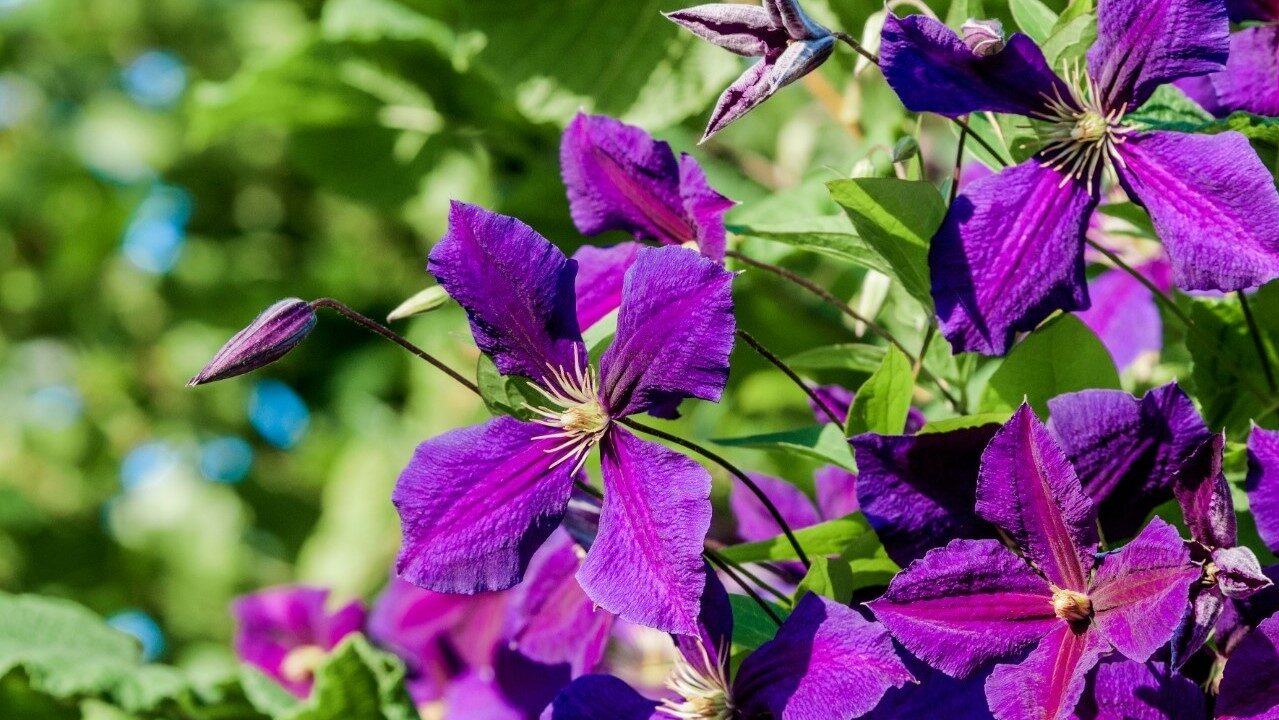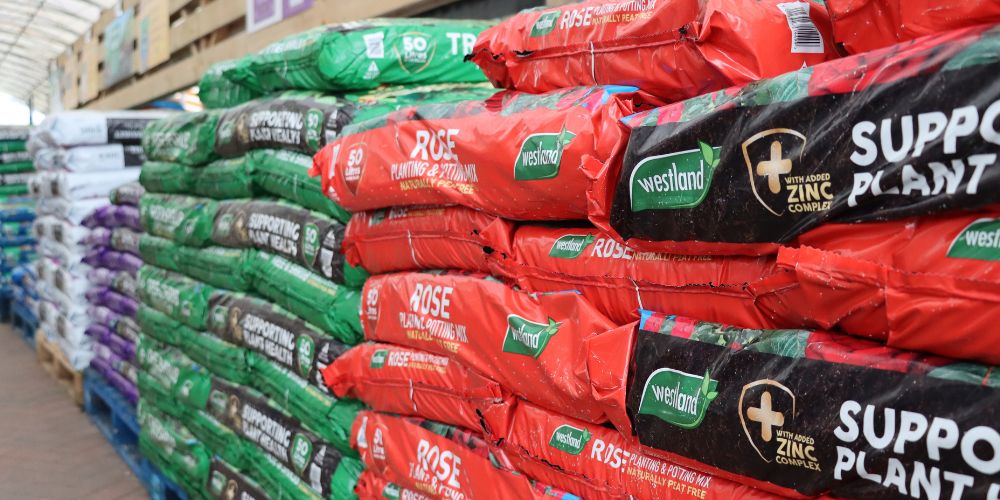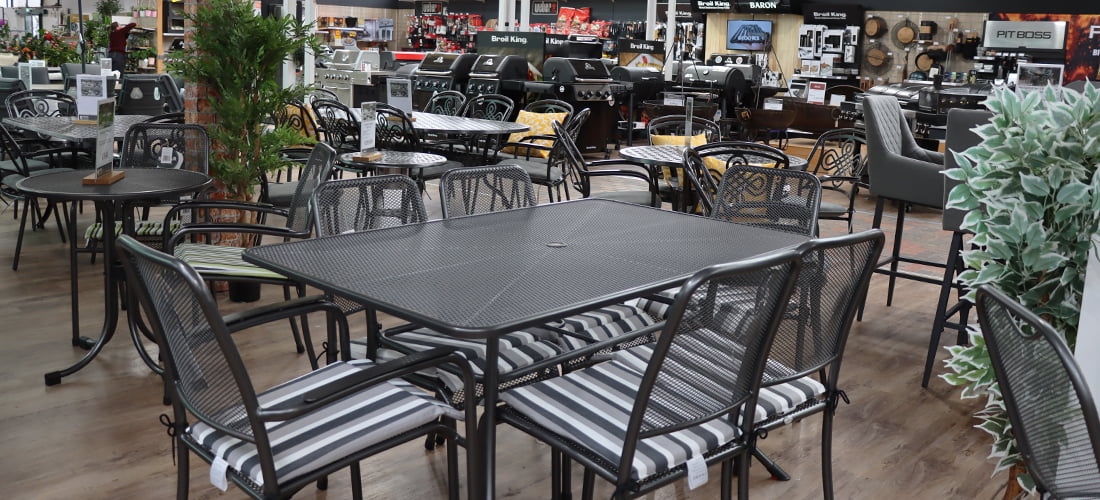Clematis is the common name given to members of the plant genus Clematis, which in turn belongs to the family Ranunculaceae. This family also includes garden flowers such as anemones and delphiniums, with the buttercup as a native example.
The word ‘clematis’ is derived from the Greek word klema meaning ‘vine-branch’, reflecting the way the plant grows and clings to its support.
The clematis flower is very unusual in that it has no petals. The sepals, which in other plants cover the emerging flower, have evolved to take the place of petals, and it is these that make the flower so colourful. Sometimes, as with the double varieties, some of the stamens have also taken on the appearance of petals.
Clematis has been grown in this country for centuries, but the only native species is Clematis vitalba or ‘Old Man’s Beard’. Its common name stems from the masses of fluffy seed heads that it produces in the autumn. According to various herbals, the stems were also smoked by shepherds and gypsies – hence its local name ‘Shepherd’s Bacca’.
Many of the Clematis types mentioned below can be viewed on our Plant Finder.
CLEMATIS TYPES
Evergreen Clematis
These plants are among the most popular forms of clematis but unfortunately they are also responsible for some of the biggest disappointments.
The evergreens can be divided into two distinct groups according to the two original species.
C. armandii is best planted in a sheltered position that also gets a fair amount of sun. This is essential so that the wood ripens and the flower buds can develop for the next season’s floral display. Avoid windy sites to prevent scorch on soft leaves.
C. cirrhosa requires a similar location to amandii and also needs a good amount of sunshine to ripen wood for flowering. The winter sun it has had, the better the flower will be.
Montanas and Alpinas
This group contains species and varieties that are among the first to flower.
C. alpina is a European species distinguished by its profusion of bright-blue nodding, bell-like flowers that open in late March or April.
C. montana is well known for vigour, creating a profusion of star-like flowers in the early spring. Depending on the variety, they will grow to heights of more than 15m and are particularly suitable for growing up quite large trees, or for covering unsightly walls or buildings. Like the alpinas, they flower in April.
Early Large-Flowered Clematis
This group produces some of the largest flowers to be seen in the garden. If you look after them properly, cultivars such as the well-known C.’Nelly Moser’ will produce a vast array of plate-sized flowers in early summer.
However, like all prima donnas they have to be carefully nurtured to create the full effect. They need plenty of water in summer (especially if in pots). A good application of potash will help them into flower.
Double and Semi-Double Varieties
These are among the most exotic of all climbing plants. They range from the almost peony-like blooms of C. ’Proteus’ to the delicate yet abundant C. viticella ‘Purpurea Plena Elegans’.
To give their best, these clematis require the same treatment as the early large-flowered varieties. But they are best planted in a sunny position, where the summer sun will ripen the current growth to provide next year’s flowers.
Many varieties are compact in growth and suitable for growing in containers.
Summer Hybrids
These clematis share a number of advantages. Firstly, they flower at a time of year when other plants are past their best. More importantly, they flower on the current year’s growth, which means they respond well to hard pruning each year.
There is only one drawback: by the time these plants have begun to flower, many if not all of the lower leaves have either yellowed or died, leaving the lower part bare and ugly. This makes the summer hybrids admirable subjects for growing through other trees and shrubs.
Clematis Viticella
POSITION
Check the label first as different cultivars prefer different aspects. Remember that winter-flowering Clematis will need a very sheltered position.
SOIL
The better the soil, the more success you will have with your clematis.
Garden soil can be improved quite dramatically over a period of time by adding organic material in the form of well-rotted manure or garden compost. If the soil is dry and sandy, then either of these materials will eventually make it more water-retentive. Heavy clay soils will also become easier to work, providing you only use manure that contains a high proportion of straw.
The primary object is to retain as much water as possible during the growing season but allow excess water to drain away freely during the dormant period. If you dig in plenty of organic matter before planting, this should start the ball rolling.
Follow this up with annual mulches of manure, compost or bark when the soil is moist, and you will eventually have an ideal growing medium.
PLANTING
Clematis must have cool roots. To help protect them against clematis wilt plant 10-15cm deeper than in the pot and with a few buds remaining below the soil level. This will enable the roots to put up new shoots if the top of the plant dies, and it also makes for a much bushier and sturdier plant.
Once you have worked out the optimum planting depth, knock the plant carefully out of its pot, taking great care not to break any of the stems. Then immediately place it in position, still taking care so as not to disturb the soil ball.
Do not dig the hole too near the wall, tree or trellis support. Clematis should be about 45cm away and the stems guided towards the wall with sturdy canes.
First place a small quantity of soil around the plant in order to keep it stable. Then start to fill in the planting hole by breaking down the sides with a fork. This stops the soil around the plant becoming compacted, and is more important with heavier soils. If the sides of the hole are too compacted, they can act almost like the walls of a pot, eventually stopping the plant from developing. As you replace the soil, firm it in gently, preferably with the heel of your foot. This is to bring the plant into good contact with the soil without destroying the structure of the soil.
Finally, tidy up around the plant and then water it. Even if the soil is moist, the action of the water will help to wash the soil around the roots so that the plant settles in straight away.
CONTAINERS
Most Clematis can be grown in containers but not the vigorous ones like C. montana. Choose a container that is at least 45cm wide and 45cm deep, with good drainage. Use John Innes No.3 or other good loam based compost. Shade the roots well as mentioned previously.
Remember the saying ‘Head in the sun, roots in the shade’.
FEEDING
Clematis are greedy feeders and impossible to overfeed. However, if you want them to give of their best and provide an abundant display of flowers, then you should avoid nitrogenous fertilizers in favour of those which are high in potash. The best fertilizers are those designed for roses. If you apply these at the same strength and with the same frequency, this will ensure a magnificent show year after year.
PRUNING
There is a very general rule that says: ‘if it flowers before the longest day, don’t prune; if it flowers after the longest day then do’. Check the label to see which group your clematis is in. There are three main categories.
1) Don’t prune but tidy the plant up and remove dead wood in June.
2) Cut back gently to a pair of good buds in February/March.
3) Cut back to 45cm (to a pair of good buds) in February/March.
PROBLEMS
Clematis wilt is the most serious problem and can cause a plant to collapse almost overnight. However recovery may be possible. If the plant has been planted correctly you can just cut off and burn the affected areas and spray with a fungicide. The plant should re-shoot just as strongly, although it may take a while.
Clematis may also attract slugs, snails, aphids and ear-wigs. These can be dealt with by using the appropriate pesticide. Mildew should be treated with a fungicide.
It is always worth buying good quality clematis such as those developed by the breeder Raymond Evison. Raymond Evison Clematis are selected from the sophisticated breeding programme run jointly with Poulsen Roser A/S.
These unique cultivars undergo 10 years of trial and assessment to guarantee reliable, free flowering and top performing clematis best suited to modern gardens.








